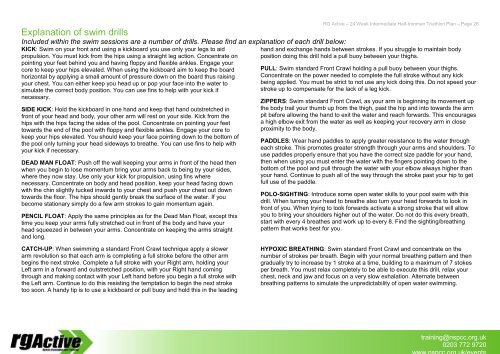Create successful ePaper yourself
Turn your PDF publications into a flip-book with our unique Google optimized e-Paper software.
Explanation of swim drills<br />
Included within the swim sessions are a number of drills. Please find an explanation of each drill below:<br />
KICK: Swim on your front and using a kickboard you use only your legs to aid<br />
propulsion. You must kick from the hips using a straight leg action. Concentrate on<br />
pointing your feet behind you and having floppy and flexible ankles. Engage your<br />
core to keep your hips elevated. When using the kickboard aim to keep the board<br />
horizontal by applying a small amount of pressure down on the board thus raising<br />
your chest. You can either keep you head up or pop your face into the water to<br />
simulate the correct body position. You can use fins to help with your kick if<br />
necessary.<br />
SIDE KICK: Hold the kickboard in one hand and keep that hand outstretched in<br />
front of your head and body, your other arm will rest on your side. Kick from the<br />
hips with the hips facing the sides of the pool. Concentrate on pointing your feet<br />
towards the end of the pool with floppy and flexible ankles. Engage your core to<br />
keep your hips elevated. You should keep your face pointing down to the bottom of<br />
the pool only turning your head sideways to breathe. You can use fins to help with<br />
your kick if necessary.<br />
DEAD MAN FLOAT: Push off the wall keeping your arms in front of the head then<br />
when you begin to lose momentum bring your arms back to being by your sides,<br />
where they now stay. Use only your kick for propulsion, using fins where<br />
necessary. Concentrate on body and head position, keep your head facing down<br />
with the chin slightly tucked inwards to your chest and push your chest out down<br />
towards the floor. The hips should gently break the surface of the water. If you<br />
become stationary simply do a few arm strokes to gain momentum again.<br />
PENCIL FLOAT: Apply the same principles as for the Dead Man Float, except this<br />
time you keep your arms fully stretched out in front of the body and have your<br />
head squeezed in between your arms. Concentrate on keeping the arms straight<br />
and long.<br />
RG Active – 24 Week Intermediate Half-<strong>Ironman</strong> Triathlon Plan – Page 28<br />
hand and exchange hands between strokes. If you struggle to maintain body<br />
position doing this drill hold a pull buoy between your thighs.<br />
PULL: Swim standard Front Crawl holding a pull buoy between your thighs.<br />
Concentrate on the power needed to complete the full stroke without any kick<br />
being applied. You must be strict to not use any kick doing this. Do not speed your<br />
stroke up to compensate for the lack of a leg kick.<br />
ZIPPERS: Swim standard Front Crawl, as your arm is beginning its movement up<br />
the body trail your thumb up from the thigh, past the hip and into towards the arm<br />
pit before allowing the hand to exit the water and reach forwards. This encourages<br />
a high elbow exit from the water as well as keeping your recovery arm in close<br />
proximity to the body.<br />
PADDLES: Wear hand paddles to apply greater resistance to the water through<br />
each stroke. This promotes greater strength through your arms and shoulders. To<br />
use paddles properly ensure that you have the correct size paddle for your hand,<br />
then when using you must enter the water with the fingers pointing down to the<br />
bottom of the pool and pull through the water with your elbow always higher than<br />
your hand. Continue to push all of the way through the stroke past your hip to get<br />
full use of the paddle.<br />
POLO-SIGHTING: Introduce some open water skills to your pool swim with this<br />
drill. When turning your head to breathe also turn your head forwards to look in<br />
front of you. When trying to look forwards activate a strong stroke that will allow<br />
you to bring your shoulders higher out of the water. Do not do this every breath,<br />
start with every 4 breathes and work up to every 8. Find the sighting/breathing<br />
pattern that works best for you.<br />
CATCH-UP: When swimming a standard Front Crawl technique apply a slower<br />
arm revolution so that each arm is completing a full stroke before the other arm<br />
begins the next stroke. Complete a full stroke with your Right arm, holding your<br />
Left arm in a forward and outstretched position, with your Right hand coming<br />
through and making contact with your Left hand before you begin a full stroke with<br />
the Left arm. Continue to do this resisting the temptation to begin the next stroke<br />
too soon. A handy tip is to use a kickboard or pull buoy and hold this in the leading<br />
HYPOXIC BREATHING: Swim standard Front Crawl and concentrate on the<br />
number of strokes per breath. Begin with your normal breathing pattern and then<br />
gradually try to increase by 1 stroke at a time, building to a maximum of 7 stokes<br />
per breath. You must relax completely to be able to execute this drill, relax your<br />
chest, neck and jaw and focus on a very slow exhalation. Alternate between<br />
breathing patterns to simulate the unpredictability of open water swimming.<br />
training@nspcc.org.uk<br />
0203 772 9720


